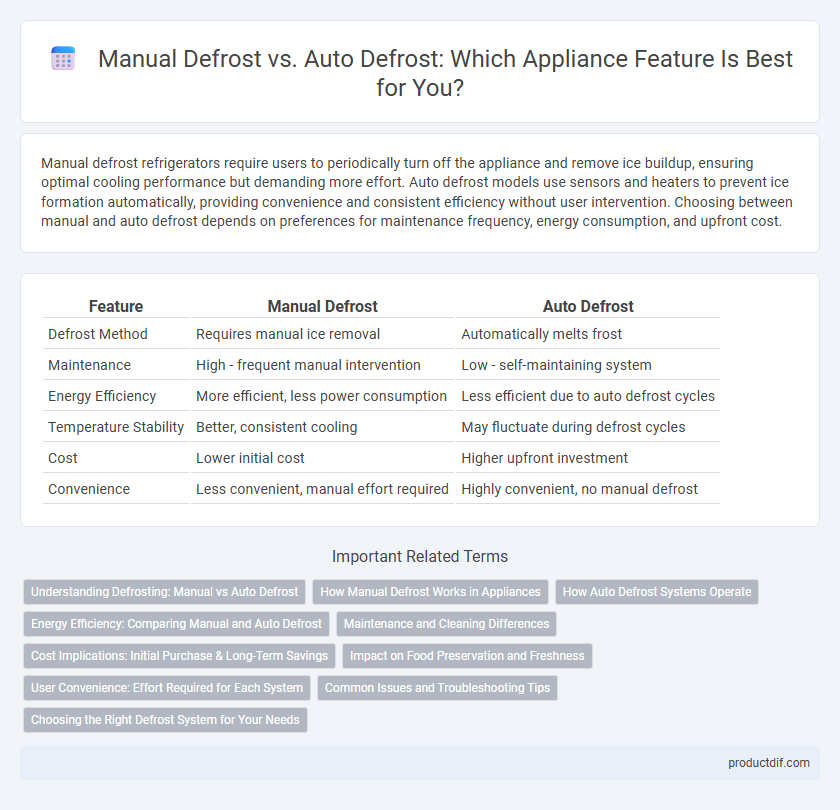Manual defrost refrigerators require users to periodically turn off the appliance and remove ice buildup, ensuring optimal cooling performance but demanding more effort. Auto defrost models use sensors and heaters to prevent ice formation automatically, providing convenience and consistent efficiency without user intervention. Choosing between manual and auto defrost depends on preferences for maintenance frequency, energy consumption, and upfront cost.
Table of Comparison
| Feature | Manual Defrost | Auto Defrost |
|---|---|---|
| Defrost Method | Requires manual ice removal | Automatically melts frost |
| Maintenance | High - frequent manual intervention | Low - self-maintaining system |
| Energy Efficiency | More efficient, less power consumption | Less efficient due to auto defrost cycles |
| Temperature Stability | Better, consistent cooling | May fluctuate during defrost cycles |
| Cost | Lower initial cost | Higher upfront investment |
| Convenience | Less convenient, manual effort required | Highly convenient, no manual defrost |
Understanding Defrosting: Manual vs Auto Defrost
Manual defrost refrigerators require users to periodically turn off the appliance and remove ice build-up by hand, preventing energy inefficiency and maintaining optimal cooling performance. Auto defrost systems, also known as frost-free, use built-in heaters and fans to automatically melt frost, reducing maintenance but potentially increasing energy consumption slightly. Choosing between manual and auto defrost depends on factors like convenience preference, energy use considerations, and how often ice forms in the appliance.
How Manual Defrost Works in Appliances
Manual defrost appliances require users to periodically turn off the unit and allow ice buildup to melt naturally, preventing frost accumulation on evaporator coils. This process involves removing food, unplugging the appliance, and using towels or pans to collect water from melting ice. Manual defrost systems are energy-efficient but demand regular maintenance to maintain optimal cooling performance and prevent damage caused by excessive frost.
How Auto Defrost Systems Operate
Auto defrost systems use built-in heaters and timers to periodically melt frost accumulation inside the freezer, preventing ice buildup and maintaining consistent cooling efficiency. Sensors detect temperature changes and activate the heating elements during specific cycles, eliminating the need for manual defrosting and reducing maintenance time. This automated process enhances energy efficiency by minimizing frost interference with heat exchange surfaces.
Energy Efficiency: Comparing Manual and Auto Defrost
Manual defrost refrigerators consume less energy by eliminating the power needed to operate automatic defrost cycles, resulting in lower electricity bills and reduced environmental impact. Auto defrost models use periodic heating elements to melt frost, which increases energy consumption but offers convenience and consistent performance. Energy-efficient appliances often favor manual defrost designs for their simplicity and reduced operational energy demands.
Maintenance and Cleaning Differences
Manual defrost refrigerators require regular ice removal to prevent buildup, making maintenance more labor-intensive and time-consuming compared to auto defrost models. Auto defrost appliances feature built-in heating elements that melt frost automatically, reducing the need for manual cleaning and minimizing maintenance frequency. Cleaning auto defrost units typically involves wiping down shelves and drip trays, whereas manual defrost units demand complete ice removal and thorough drying to prevent mold and odors.
Cost Implications: Initial Purchase & Long-Term Savings
Manual defrost refrigerators typically have a lower initial purchase price compared to auto defrost models, making them a cost-effective option upfront. However, auto defrost appliances often lead to long-term savings by reducing energy consumption associated with frost buildup and eliminating the need for manual defrosting labor. Over time, the higher energy efficiency and convenience of auto defrost refrigerators can offset their higher initial cost, resulting in overall better value.
Impact on Food Preservation and Freshness
Manual defrost refrigerators prevent ice buildup by requiring periodic thawing, which helps maintain consistent cold temperatures and preserves food freshness longer by minimizing moisture fluctuations. Auto defrost models use automatic defrost cycles to reduce frost, but this can cause slight temperature rises that may impact delicate food textures and accelerate spoilage in certain perishable items. Choosing manual defrost units benefits long-term food preservation and freshness retention due to stable temperature environments and reduced moisture variation.
User Convenience: Effort Required for Each System
Manual defrost refrigerators require users to periodically turn off the appliance and remove ice buildup, involving significant time and physical effort. Auto defrost systems eliminate this chore by automatically melting frost, enhancing user convenience with minimal maintenance. The reduced effort in auto defrost models improves overall appliance usability and time management for homeowners.
Common Issues and Troubleshooting Tips
Manual defrost refrigerators often face issues such as ice build-up, which can reduce cooling efficiency and require regular maintenance to prevent blockages and uneven temperatures. Auto defrost models commonly experience frost accumulation on the evaporator coil due to faulty defrost timers or heaters, causing the appliance to cycle frequently and consume more energy. Troubleshooting involves checking and replacing faulty defrost components in auto defrost units, while manual defrost appliances benefit from scheduled defrost cycles and inspection for seal integrity to maintain optimal performance.
Choosing the Right Defrost System for Your Needs
Manual defrost refrigerators require periodically turning off the appliance to melt accumulated frost, offering better energy efficiency and lower initial costs, ideal for small households or those seeking simplicity. Auto defrost models use built-in heaters to melt frost automatically, providing hassle-free maintenance and consistent temperature control, suited for larger families or busy lifestyles. Selecting the right defrost system depends on balancing convenience, energy consumption, and budget preferences tailored to your specific appliance use.
Manual Defrost vs Auto Defrost Infographic

 productdif.com
productdif.com